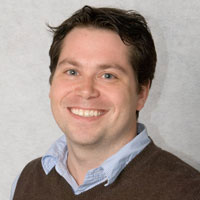Professor Robert C. McCarthy
The ScienceDaily article Neanderthals Speak Again After 30,000 Years said
“Dr. Robert McCarthy, an assistant professor of anthropology in the Dorothy F. Schmidt College of Arts and Letters at Florida Atlantic University, has reconstructed vocal tracts that simulate the sound of the Neanderthal voice.Using 50,000-year-old fossils from France and a computer synthesizer, McCarthy’s team has generated a recording of how a Neanderthal would pronounce the letter ‘e’. The brief recording doesn’t sound like any letter in modern languages, but McCarthy says that’s because Neanderthals lacked the ‘quantal vowels’ modern humans use. Quantal vowels provide cues that help speakers with different size vocal tracts understand one another.”
Robert C. McCarthy, Ph.D. is Assistant Professor of Anthropology, Florida Atlantic University.
Robert authored Anthropoid cranial base architecture and scaling relationships, and coauthored Posterior maxillary (PM) plane and anterior cranial architecture in primates, The ontogeny of cranial base angulation in humans and chimpanzees and its implications for reconstructing pharyngeal dimensions, and Ontogeny of postnatal hyoid and larynx descent in humans.
In his research, Robert is trying to figure out how skulls are put together. His dissertation work demonstrated that integration between parts of the brain, cranial base, and face limits skull form in primates, and humans in particular. These constraints have many “down-the-line” consequences.
First, the head and neck surround the speech apparatus, and the uniquely-shaped modern human skull sets up a vocal tract capable of housing a long, descended tongue with the ability to form vowels such as [i] (“see”), [a] (“saw”) and [u] (“sue”). He has recently reconstructed vocal tracts for Neanderthals and other extinct humans, and, in combination with Dr. Philip Lieberman from Brown University, has succeeded in synthesizing Neanderthal speech sounds.
A second consequences of cranial reorganization is that space in the face is at a premium. Teeth cannot erupt into the jaws until sufficient space opens up, and so delays in tooth crown mineralization and eruption in modern humans may be related to how small our faces are and how slowly they grow. Several ongoing projects are testing the extent to which brains, faces, and teeth affect one another during hominin evolution.
Finally, characters in the skull used to reconstruct phylogenetic relationships are unlikely to be independent from one another since the skull is put together like a jigsaw puzzle. He is currently working on applying techniques from evolutionary developmental biology (“evo-devo”) to address this issue.
Robert earned his B.A. at Rutgers University in 1996, his M. Phil. at George Washington University in 2000, and his Ph.D. at George Washington University in 2004.
Listen to his Earth & Sky interview Listen to Neanderthals speak and his interview on Quirks & Quarks.
